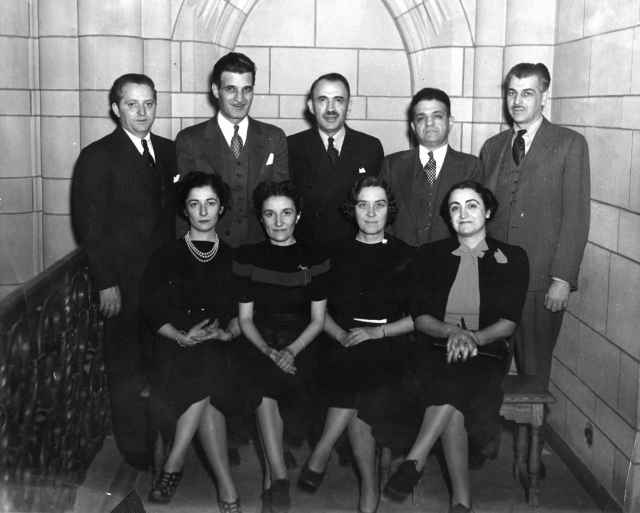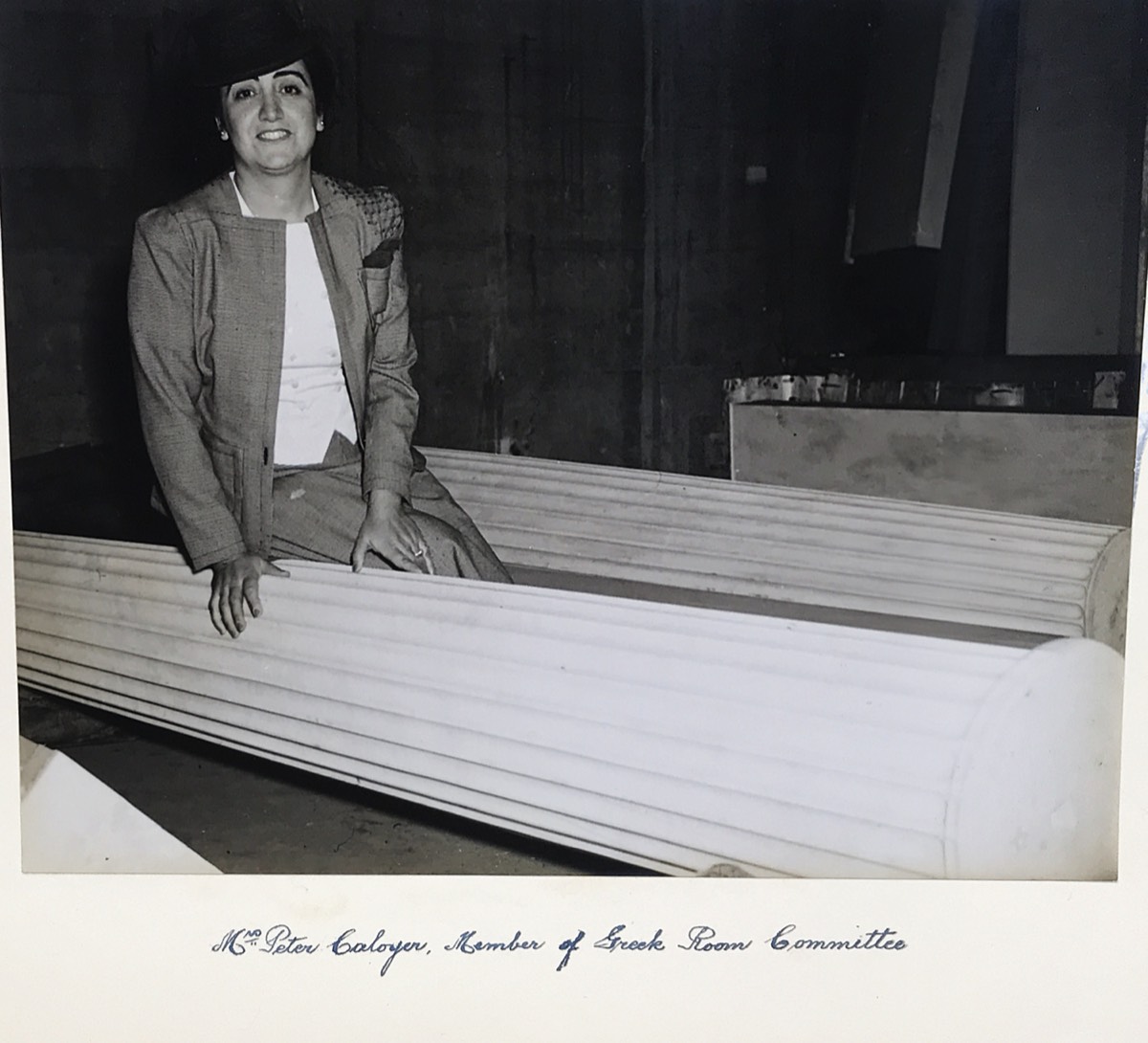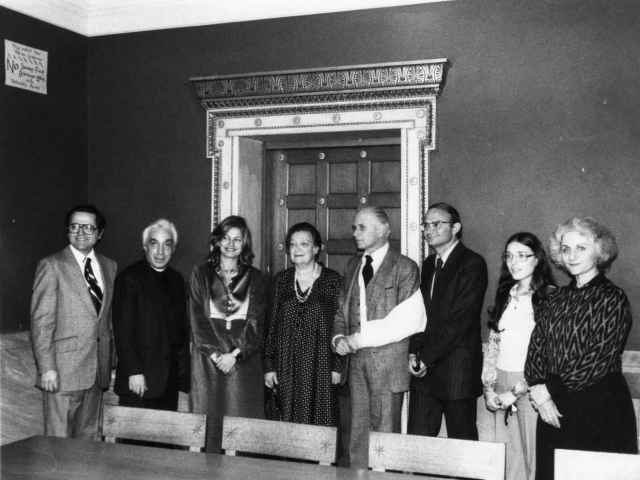
A Brief History
In 1928, a group of energized students at the University of Pittsburgh, answered the call of Mrs. Ruth Crawford Mitchell and stepped up to take on the challenge of creating the Greek Room. They enlisted regional immigrants of Greek descent, some in position of leadership of the then young – but so energetic – Greek community, to join them in this challenge. Over the next 15 years, the students, all who eventually graduated and began successful careers, with the support of the Greek community of all of Western Pennsylvania, achieved the unthinkable. The Greek Nationality Room was a reality.
These visionary individuals, with the conviction that “we” and “togetherness” achieves great feats over the “me”, initiated, maintained and grew a vigorous program of intercultural involvement and exchange. A large sum, for its time, was donated to the University as an initial endowment for what would soon become a source of financial support of a program of annual student scholarship to facilitate study in a Greek academic or cultural institution, which more recently was extended to include the beautiful island of Aphrodite, Cyprus, a means of facilitating inspiring lectures, seminars, concerts, exhibitions, and social events which focus on the heritage of Greece, from its ancient times, to the more modern.
Over this time, those visionary individuals came together with members of other Nationality Room committees and people from the regional sister communities to celebrate what unites us and how Hellenism, in its universalizing embrace, shaped those heritages and cultures.
Among the notable founders are Charles T. Tumazos, Lillian Demestichas, Peter and John Antonoplos, James K. Steliotes, Dr. Stephen Pamphilis, Iro Caloyer, Peter Caloyer, Sarantis (Socrates) Lardas, Peter Demos, Thomas Birris, Peter G. Copetas, Sam Hanna, John Harris, Constantine A.Contis, George Loutsion, and the most notable of all, Nicholas Kalimerakis (Kalmer).
The Greek Room was formally dedicated on the 7th of November, 1941. It was such a glorious event. It brought together everyone in the Greek community. Led by the great Athenagoras Spyrou, the Archbishop of the then Greek Orthodox Archdiocese of North and South America, a remarkable and inspiring historical figure of the Greek-American community, who would soon be elected to lead the then approximately 300 million Orthodox Christians of the world as Ecumenical Patriarch, it inspired not only the Greek community to think of the ways in which its culture could be shared with others, but also of how to bring the Greek community with sister communities.
Universalizing Hellenism. We the People. A more perfect Union.

A Timeline of Major Events (click on arrow to open)
1926 Charles Tumazos, Nicholas Kalmer, Lillian Demestichas, Peter Antonoplos, James Steliotes, Stephen Pamphilis, Sarantis Lardas, Thomas Birris, G. Koutris, G. Zachariades, and Peter Demos respond to the call of Mrs. Ruth Crawford Mitchell and Chancellor Bowman to raise funds and mobilize the Greek-American community of Western Pennsylvania to realize the crafting of the Greek Nationality Room inside the nascent Cathedral of Learning.
1930 Charles Tumazos, Lillian Demestichas, and Nicholas Kalmer were in constant communication with the Government of Greece to secure support in the form of plans and materials, and financial support, to build the Room. Nicholas Kalmer contacted Eleftherios Venizelos to enlist him in the effort, and together, the Committee reached out to George Papandreou, Minister of Education (later to become Prime Minister), and Ioannis Metaxas to secure assistance in finding an architect, material, and financial support.
A benefit dance was held in the Schenley Hotel Ballroom in February and in October, university students of Greek descent presented the play "Merope" at the Enright Theater in East Liberty.
Miss Europe, Alice Diplarakou, came to the University and gave a lecture, with all proceeds going to the Greek Room fund.
1931 The play "The Young Diakos" was presented by the St. Nicholas Cathedral Greek School to help raise funds for the Greek Room.
A benefit dance was held in October at the Fort Pitt Hotel.
1932 The Committee enlisted the help of Professor George Mylonas of Washingtonton University at St. Louis, who obtained plans for a classical design for the Room, in lieu of the Greek Government's proposal for a Byzantine-style Room.
1933 The classical Room design was realized by a young Greek architect, John Travlos, from the Polytechnic School of Athens.
1935 Regional Cretan, Icarian, and Spartan Associations raised a substantial amount of money to help cover the costs to ship the marble for the Room from Greece.
In April, Michael Dorizas came for a fund-raising lecture.
George Vlastos, a regional wrestler volunteered a match with proceeds towards the Greek Room Fund.
1937 The Greek Amateur Players of East Pittsburgh came together and presented a play at Schenley High School with proceeds going to the Greek Room Fund.
Mrs. Iro Caloyer traveled to Athens with her family to vacation, and in the process, contacted the government for assistance to obtain the required materials to construct the Room.
On the 25th of July, the official deed of gift to the university was signed, including an amount dedicated to a scholarship in the name of Charles T. Tumazos.
Mr. James Steliotes traveled to Greece to secure the marble material. On the 30th of October he sent a telegram to Ruth Crawford Mitchell: "written confirmation granted".
1938 The Greek government appointed a committee to serve as an intermediary for assistance in the realization of the Greek Room.
The Greek Ministry of Education commits a substantial sum to cover the cost of shipment of the Room construction material including the precision-cut marbles from the famed quarry of Penteli, the same quarry from which the material for the columns of the Parthenon were obtained.
1939 The government of Greece provided further financial support for shipping the construction material.
1940 9400 kilograms of the highest-grade marble from the quarry of Penteli, precision-cut and shaped by Costa Mastoras, the same craftsman tasked to reconstruct the Acropolis structures, was shipped.
The material arrived at the port of New York on the 5th of April, just one week before shipping was halted in the Mediterranean.
In June, a general, community-wide committee was formed to assist in raising funds for the completion of the Greek Room,
1941 The Greek Room was completed on time and as planned. On November 7th, it was formally dedicated in the presence of more than 1200 persons by His Eminence Athenagoras, Archbishop of the Greek Orthodox Archdiocese of North and South America.
On the evening of the Dedication, Mr. Peter Antonoplos held a reception for the many invited and visiting dignitaries and committee members at his home.
1942 In June, Emmanuel Tsouderos, Prime Minsiter of Greece visited the Greek Room and placed the architectural plans together with formal dedication documents from Greece inside a special cubby in the Greek Room.
In November, the First Anniversary was celebrated.
1950 His Eminence Archbishop Michael, the successor of Archbishop Athenagoras (who had been elected as Ecumenical Patriarch) visited the Greek Room.
1952 Dimitrios Lambros, Minister Counselor of the Royal Greek Embassy visited the Greek Room.
1954 George Melas, Ambassador of Greece to the USA, visited the Greek Room.
1956 Apostolos Voyatzis, General Counsel of the Greek Labor Movement visited the Room on August 7th.
His Grace Polyefktos becomes the first prelate of the newly-created Archdiocesan Sixth District and visits the Greek Room together with many dignitaries.
1958 In November, Queen Frederika of Greece visited the Greek Room.
1961 In October, His Beatitude Benediktos, Patriarch of Jerusalem, visited the Greek Room.
1962 The Greek Room awards its first scholarship, named in honor of Charles T. Tumazos.
1965 In April, Corinna Tsopei, Miss Universe 1964, visited the Greek Room.
1967 In February, Princess Irene of Greece, visited the Greek Room.
1983 In October, the film "Antigone" was featured as part of outreach to sister communities.
1984 City high school students participated in an essay contest in honor of the "Nikos Kazantzakis Centennial Yearr".
1991 Dr. Spyros Vryonis of the Onassis Center at New York University was invited to lecture at the March 25th celebrations.
The 50th Anniversary of the Greek Room was celebrated.
1997 Dr. Paul Pappas of West Virginia University was invited to lecture at the March 25th celebrations.
1998 Dr. Van Coufoudakis of Indiana University-Purdue University was invited to lecture at the March 25th celebrations.
2001 The 60th Anniversary of the Greek Room was celebrated.
2021 The 80th Anniversary of the Greek Room was celebrated with a unique, and historical program, celebration, and tribute, in line with the Greek Room's Mission and intercultural vision. CLICK HERE for details.
There are more than 100 worthy stewards who have participated in the Executive Committees of the Greek Nationality Rooms since its dedication and each one offered an important part of the whole that kept the culture inspired by this Room alive over the years.
Among them, however, a few stood out for their leadership and considerable investment of time and personal sustenance to ensure that the Greek Nationality Room’s programs grew and reached out – uniting the community and also nurtured the generosity of the community, by expanding the endowment and raising the quality of the scholarship.
Notable stewards include George Commandaros, John Hanna, Mary Vasilakis, Venetia Vlastos Moreno, Dr. Christos Balouris, and Dr. Dimitris Kraniou.
These leaders, founders and stewards, raised the interest of distinguished individuals to come to Pittsburgh and to visit the Room and use the room as a tangible vehicle to promote Hellenism here and abroad. From great spiritual shepherds like Archbishop Michael and Archbishop Athenagoras of the then Archdiocese of North and South America, who would soon become Ecumenical Patriarch of the Eastern Orthodox Christian Church, to Prime Minister Tsouderos of Greece, the Greek Royal Family, distinguished scholars, and even Miss Universe of 1964.
